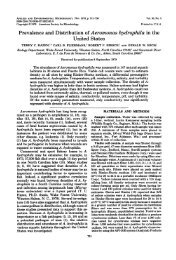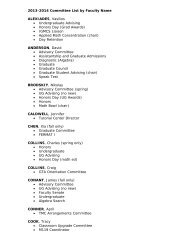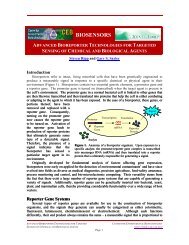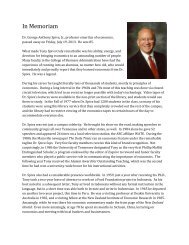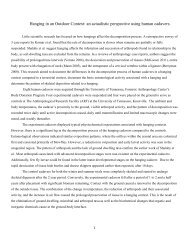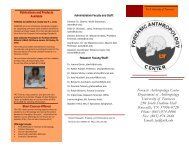Species of Xerula from sub-Saharan Africa
Species of Xerula from sub-Saharan Africa
Species of Xerula from sub-Saharan Africa
You also want an ePaper? Increase the reach of your titles
YUMPU automatically turns print PDFs into web optimized ePapers that Google loves.
Fungal Diversity<br />
mostly plane but with low umbo, smooth, matt,<br />
minutely laccate (30×), with <strong>sub</strong>tle blackish<br />
radiating streaks or reticulate pattern near<br />
margin, outward with scattered paler flecks;<br />
umbo darker, minutely roughened (30×), in<br />
part appearing frosted (i.e. hyaline hairs);<br />
margin entire, not striate, perhaps incurved,<br />
thin; flesh white, outward very thin. Lamellae<br />
adnate with significant decurrent tooth, white<br />
when fresh, near "light ochraceous buff" after<br />
drying (in one specimen developing deep rust<br />
color <strong>from</strong> necropigment), close to <strong>sub</strong>distant,<br />
somewhat ventricose, up to 10 mm deep, in<br />
three tiers; margin entire, smooth, sometimes<br />
with evidence <strong>of</strong> cheilocystidial palisade,<br />
delicately marginate in limited areas. Stipe 85-<br />
160 mm long to ground level, 2-5 mm broad<br />
upward, tapering slightly upward, swollen to 6-<br />
8 mm broad just above pseudorhiza, pale and<br />
somewhat flaired apically, neutral brown<br />
downward, longitudinally lined, obscurely<br />
furfuraceous, hollow; pseudorhiza beet-shaped,<br />
7-10 mm broad at widest point, then tapering<br />
gradually to at least 35 mm long, involving<br />
significant soil so as to obscure color, minute<br />
areas <strong>of</strong> thin pale tomentum between soil<br />
particles. Taste mild; odor weak.<br />
Pileipellis constructed <strong>of</strong> a single<br />
variable element. Pileocystidia (Fig. 8)<br />
pedicellate, thin-walled, hyaline to pigmented,<br />
not apparently clamped, <strong>of</strong> two types (with<br />
intermediates): 1) 27-52 × 13-24 µm, sphaeropedunculate,<br />
short-pedicellate, apparently<br />
arising <strong>from</strong> wide or inflated hyphae; contents<br />
homogeneous, pigmented olive brown in small<br />
individuals, <strong>sub</strong>hyaline in larger individuals;<br />
and 2) pileal hairs 50-198 × 6-14 µm (at widest<br />
point), pedicellate, clavate or extended into a<br />
<strong>sub</strong>cylindric or cylindric extension, commonly<br />
slightly inflated proximally (as though an<br />
extension <strong>of</strong> a clavate individual), thin-walled,<br />
hyaline, not apparently clamped. Pleurocystidia<br />
(Fig. 9) 78-122 × 19-30 µm, pedicellate,<br />
fusiform with wide, bluntly rounded<br />
extension to fusiform with prolonged neck and<br />
capitulum (<strong>sub</strong>lecythiform), not clamped,<br />
hyaline, thin-walled; contents homogeneous;<br />
capitulum not refringent. Basidia (Fig. 10) 47-<br />
75 × 12-19 µm, narrowly clavate with slightly<br />
pinched base, 2-spored, occasionally sclerified,<br />
without clamp connection; contents multiguttulate<br />
when young, with guttules coalescing to<br />
3-4 by maturity. Basidiospores (Fig. 10) <strong>from</strong><br />
hymenium 14.5-18 × 11-15 µm [E = (1.15-)<br />
1.23-1.44; E m = 1.23; L m = 16.2 µm], <strong>sub</strong>ovate,<br />
ellipsoid to <strong>sub</strong>tly <strong>sub</strong>limoniform, delicately<br />
dimpled, thin-walled, hyaline; contents<br />
opalescent to uniguttulate. Basidiospores <strong>from</strong><br />
stipe apex and/or pileus surface 16-21 × 13-18<br />
µm (E = 1.00-1.33; E m = 1.18; L m = 18.5 µm),<br />
<strong>sub</strong>globose, broadly ellipsoid, occasionally<br />
<strong>sub</strong>limoniform, thin- to thick-walled (wall<br />
never more than 1 µm thick), delicately<br />
dimpled. Lamellar margin sterile, extending<br />
significantly in KOH, a solid palisade <strong>of</strong><br />
cheilocystidia. Cheilocystidia (Fig. 10) (36-)<br />
56-146 × (8-)13-30 µm, pedicellate, clavate in<br />
smaller individuals, sometimes <strong>sub</strong>tly<br />
capitulate, fusiform to broadly cylindrical in<br />
larger individuals with slender pedicel, hyaline,<br />
firm-walled, without clamp connection;<br />
contents homogeneous. Stipe apex minutely<br />
scurfy with white tomentum (composed <strong>of</strong><br />
spores plus caulocystidia). Apical caulocystidia<br />
(Fig. 11) 50-165 × 15-25 µm, a turf <strong>of</strong> clavate<br />
to lobed individuals, producing broadly<br />
cylindrical individuals with narrow pedicel,<br />
hyaline, thin- to thick-walled (wall up to 1 µm<br />
thick); contents homogeneous. Stipe<br />
midsection apparently with a thin, appressed<br />
layer <strong>of</strong> surface hyphae 6-11 µm broad,<br />
perhaps involved in slime, producing a lawn <strong>of</strong><br />
side branches <strong>of</strong>ten gathered into erumpent<br />
fascicles; caulocystidia (Fig. 11) 49-223(-300)<br />
× 12-20 µm, clavate in smaller individuals,<br />
extended to fusiform, elongate-fusiform to<br />
cylindric in longer individuals, rarely furcate<br />
near apex, usually with slender pedicel, thin-,<br />
firm- or thick-walled (wall never more than 1<br />
µm thick); contents homogeneous, perhaps<br />
slightly pigmented toward tan.<br />
Commentary: These specimens are segregated<br />
<strong>from</strong> other similar basidiomata as<br />
follows: 1) pileipellis with extended pileocystidial<br />
hairs; 2) 2-spored basidia; 3) <strong>sub</strong>globose<br />
to broadly ellipsoid (rarely <strong>sub</strong>limoniform)<br />
spores; 4) pleurocystidia fusiform-capitate with<br />
extended, broadly rounded neck; and 5) welldeveloped<br />
midstipe caulocystidia. The taxon<br />
belongs in sect. Albotomentosae. Pileipellis<br />
"hairs" are extensions <strong>of</strong> clavate pileocystidia,<br />
but sphaeropedunculate individuals are more<br />
127





